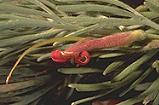Many species do not display their flowers well, but some have flowers which are bright and showy. They attract nectar-feeding birds and it is thought that Adenanthos may be pollinated by birds. Sometimes the flowers are called 'jug flowers' after their shape and the plants are often called 'woollybush', referring to the hairy foliage of many of the species. As with many members of this family, the leaf shapes and forms vary considerably - some have fine hairy leaves and others are oval or lobed. Here are three species to look out for. Adenanthos detmoldii F. Muell.The Encyclopaedia of Australian Plants notes that it grows from 2 to 4 metres high by 2 to 3 metres. wide. I only hope that this is not correct as mine is planted beside a path! The yellow and orange colour of the flowers is uncommon in the genus which mostly have red or pink flowers. The typical flower form of the Proteaceae family can be clearly seen in specimens of this species. Prior to maturity, and while the slightly thickened style end is still enclosed by the perianth limb, pollen is released from the anthers onto the style end. At this time the stigma is not receptive and, although pollen adheres to the stigma, pollination does not take place. The style is finally released as the flower opens (at anthesis) and it becomes a pollen-presenter to nectar-feeding birds. Pollen rubs off on the head of the bird, which carries it to another flower a little older than the first whose stigmatic surface is now receptive. Pollination thus takes place. Adenanthos cunninghamii Meissner *Select the thumbnail image or highlighted name for a higher resolution image (41k). Adenanthos cuneatus Labill.The specific name of this species refers to the wedge shaped leaves that are silvery-grey, or, when young, a beautiful bronze-red. This species has several common names - 'Bridle bush' (Esperance area, Western Australia), 'Sweat-bush' (Hopetoun area), 'flame bush' and 'coastal jug-flower'. The first two names refer to the apparent liking of horses for this species and it is claimed that they begin to sweat after eating the young tips. The plant is common along the south coast of Western Australia. It is a spreading small to medium shrub up to 2 metres. The flowers are dull red with a greenish base. It was introduced into Great Britain in 1824 and appears to be hardy but possibly short-lived in some areas. From "Eucryphia", the newsletter of the Australian Plants Society (Tasmania), December 1999. * In the Flora of Australia Vol. 16, A cunninghamii is regarded as "a confusing and enigmatic plant which is now considered a hybrid between A.sericeus and A.cuneatus." Thanks to Jim Barrow, Wildflower Society of Western Australia Newsletter, August 2000, for this clarification.  [Front Page] [Features] [Departments] [Society Home] [Subscribe] Australian Plants online - September 2000 |



